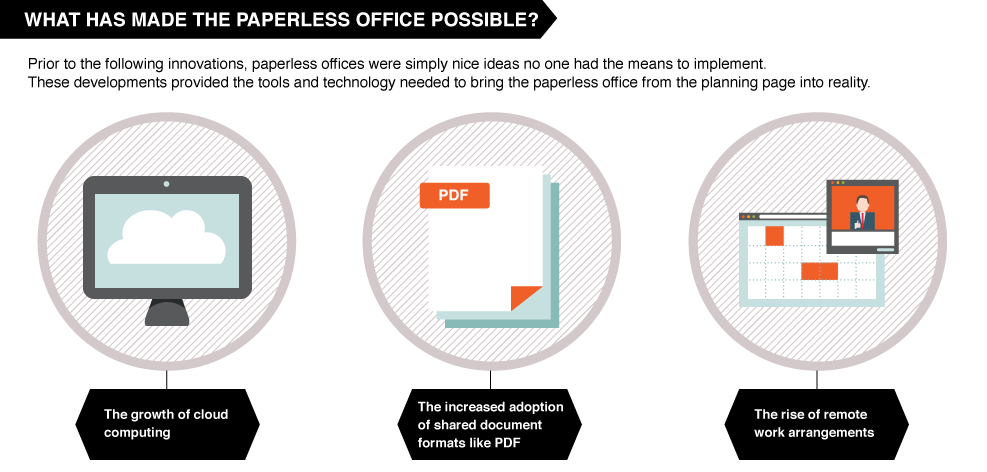This is the first part of a three-part series on how to kick the habit of paper in the workplace.
The paperless office has become a benchmark of the modern business landscape. With new technologies that can significantly improve productivity (and reduce your environmental impact) isn’t it time that your office went paperless?
This is a big move for you and your team, so make sure you understand the transition before you jump in. Depending on the size of your company, numerous technologies will become your best friend in replacing those pesky mountains of paper.
Although this is a somewhat tedious undertaking, the benefits far outweigh the cons: less clutter, more environmentally conscious, and a more organized, modern work environment.
Planning for paperless
Firstly, not everything needs to be switched to digital at once. It isn’t necessarily efficient to make this transition with the mindset that everything needs to be scanned – because it doesn’t. Some materials might be past their function or relevance and are best laid to rest in that big recycling bin.
Temporary losses in productivity are to be expected when first making the move to paperless. After all, you and your staff are used to the way things have always been done. When you throw in the potential for issues with technology and retraining staff, this decision can seem overwhelming. However, if you’ve properly anticipated these hiccups, the transition will be much smoother.
Set a realistic goal based on the number of materials that need to be scanned. It’s nothing short of cruel to assume you can lock up your employees for a weekend of non-stop scanning. Depending on the size of your company, it’s not a bad idea to look into records digitization services like Iron Mountain, or renting some additional scanners.
You’ll also need to plan for where all of your digital records will live – and how you’re going to access them when needed. While in-document searching is now fairly advanced, you should be able to find what you’re looking for without relying on it. Take stock of all the records and create a map of your documents. Standardize your document and folder naming processes. You’ll want to organize and name files and folders in a logical way so that someone who was used to the old filing system would be easily able to find it.
Environmental impact
While saving the environment may not have been one of your goals of going paperless, it is obviously one of the big benefits of making the jump. The manufacturing of paper products, ink cartridges, and similar materials contribute significantly to pollution, deforestation, and our ever-growing landfills.

Infographic snippet from Nitro, a digital document company based in San Francisco.
Pros, cons & the great paperless debate
PROS
- It’s hard to recover information from a piece of paper that’s been destroyed. This is the beauty of going paperless – thanks to affordable cloud storage, your information is stored securely and accessible at your convenience.
- Not using paper will save you money. Take a look at the amount your business currently spends on paper supplies. Now picture that cut down almost entirely. Forever. Not a bad deal.
- It’s no great secret that a paperless office is good for the environment. Clean air is nice – save some trees.
CONS:
- It can be time-consuming and tedious to make the transition. It’s also a decision that cannot easily be backed out of.
- You may not actually have all that much paper in your office. Weigh the cost of digital storage versus your company’s current paper expenses.
The verdict
There’s little doubt that paperless is where businesses are moving towards. With advancements in mobile applications, cloud storage, and file sharing changing the landscape of the modern office, the change is easier than ever – and getting easier.
In next few parts of the series, we’ll detail how you can digitize your records, as well as some handy apps and tools for a paperless workflow.
Boost your sales by offering your customers financing.
The information, views, materials and opinions contained in this article are for general informational purposes only, are not intended to constitute commercial, legal or other professional advice, and should not be relied on or treated as a substitute for specific advice relevant to particular circumstances.
FinanceIt Canada Inc. (“Financeit”) make no warranties, representations or undertakings about any of the content of this article (including, without limitation, any as to the quality, accuracy, completeness or fitness for any particular purpose of such content), or any content of any other article referred to or accessed by hyperlinks through this article. Although we make reasonable efforts to update the information regularly, Financeit makes no representations, warranties or guarantees, whether express or implied, that the content on our site is accurate, complete or up-to-date.


